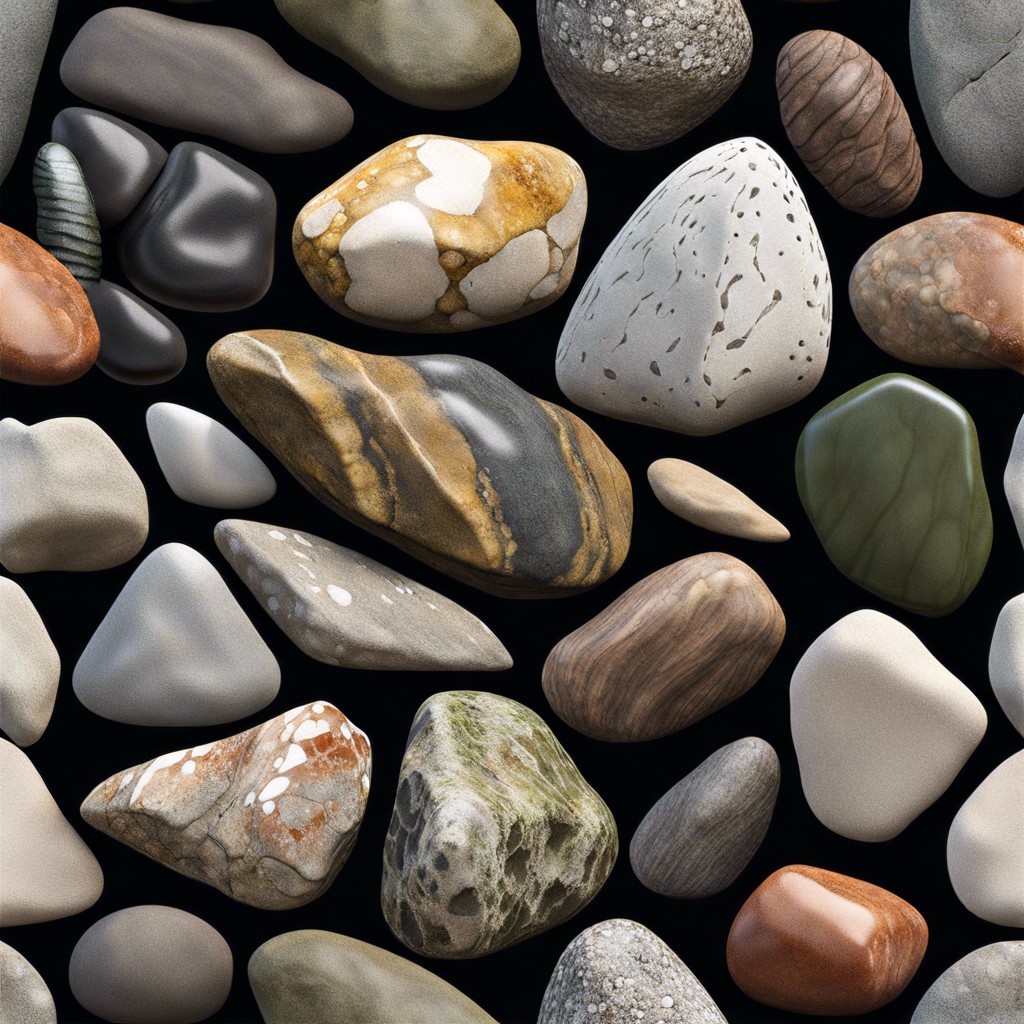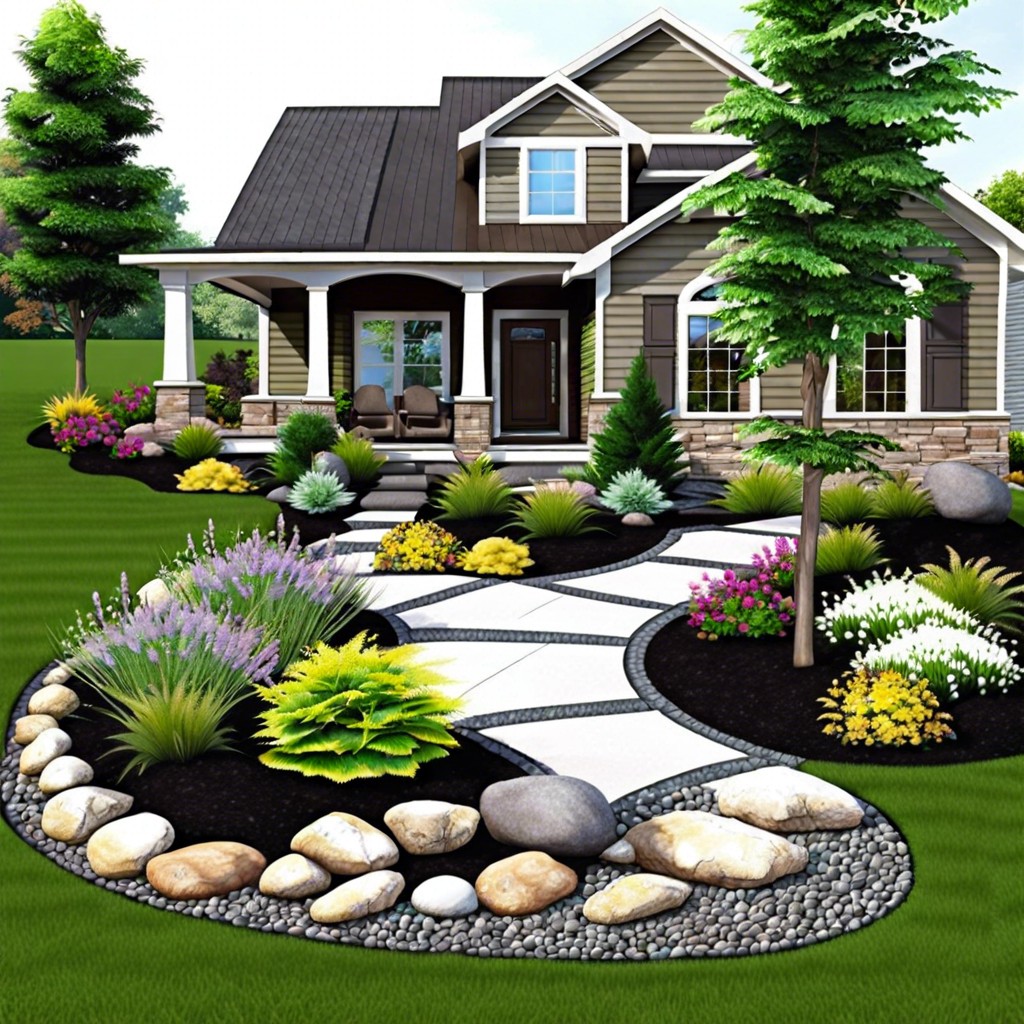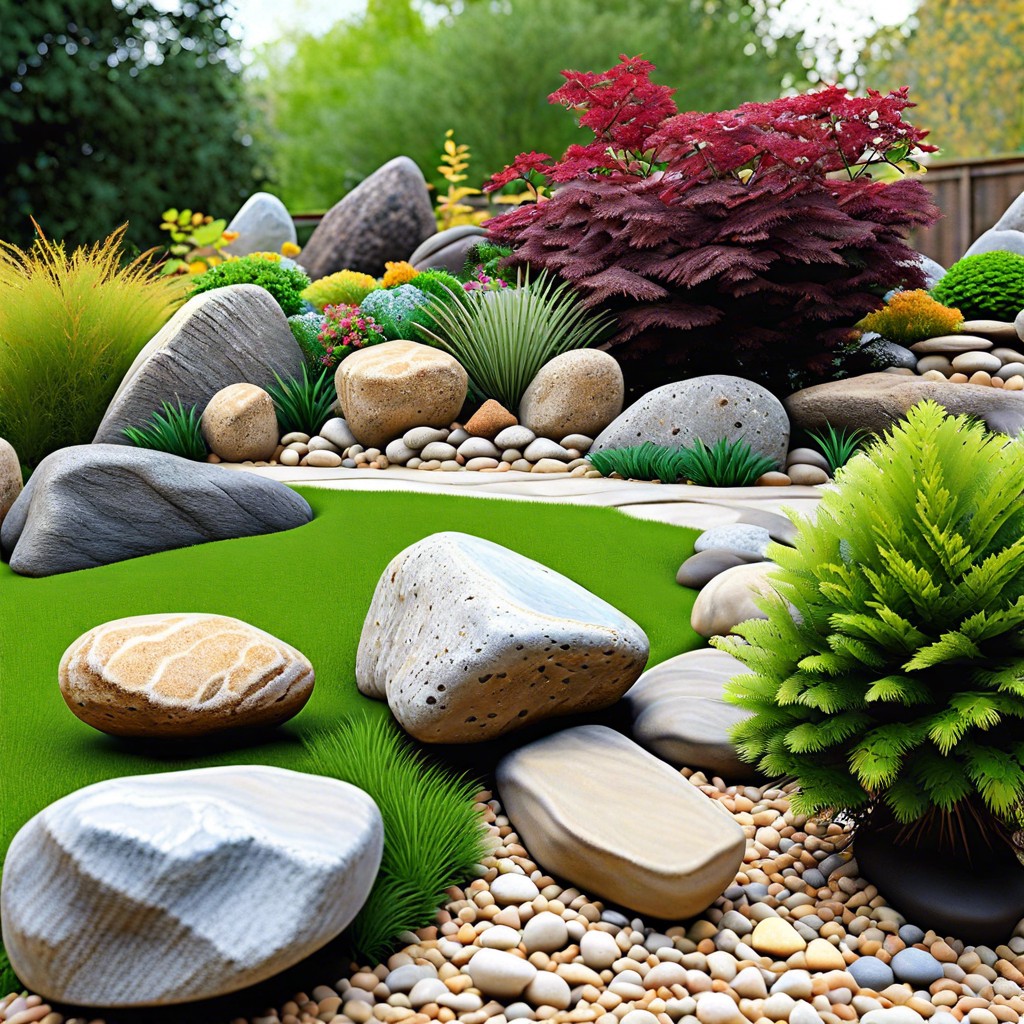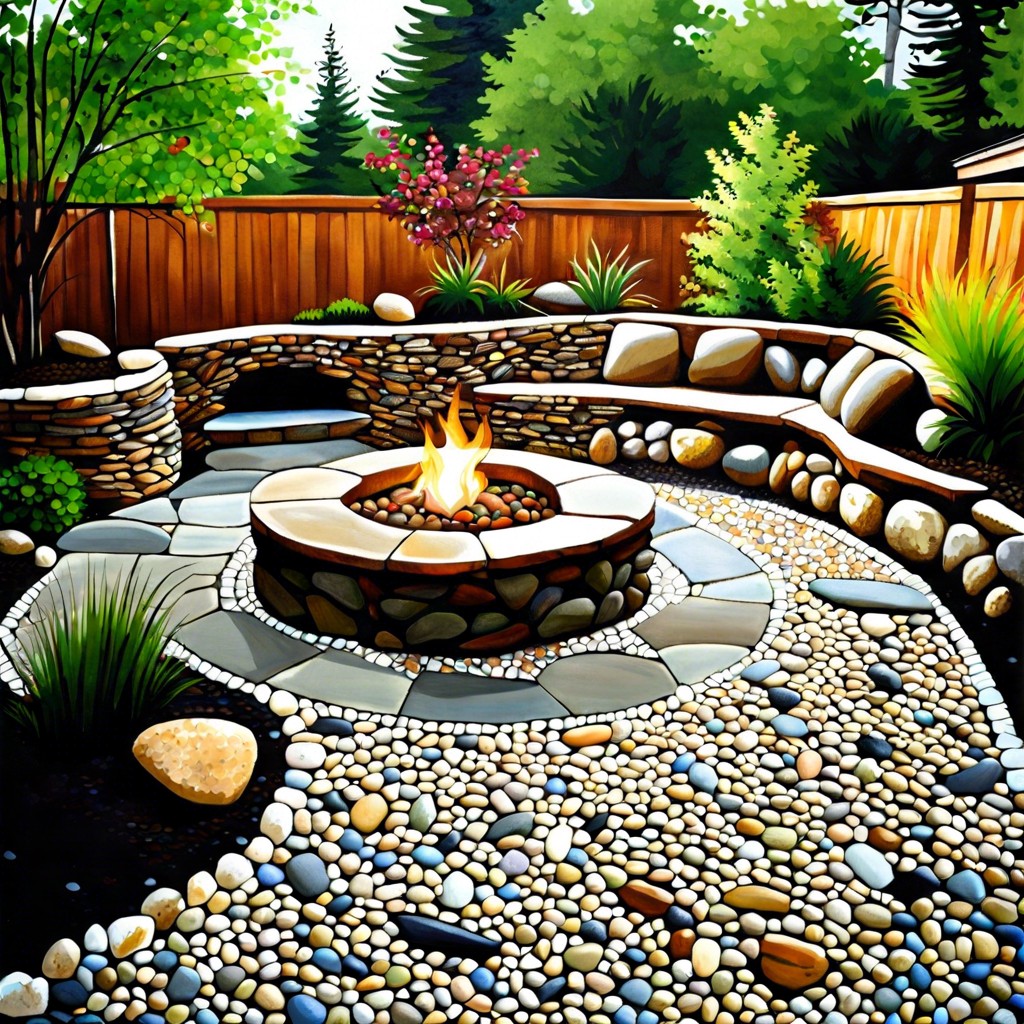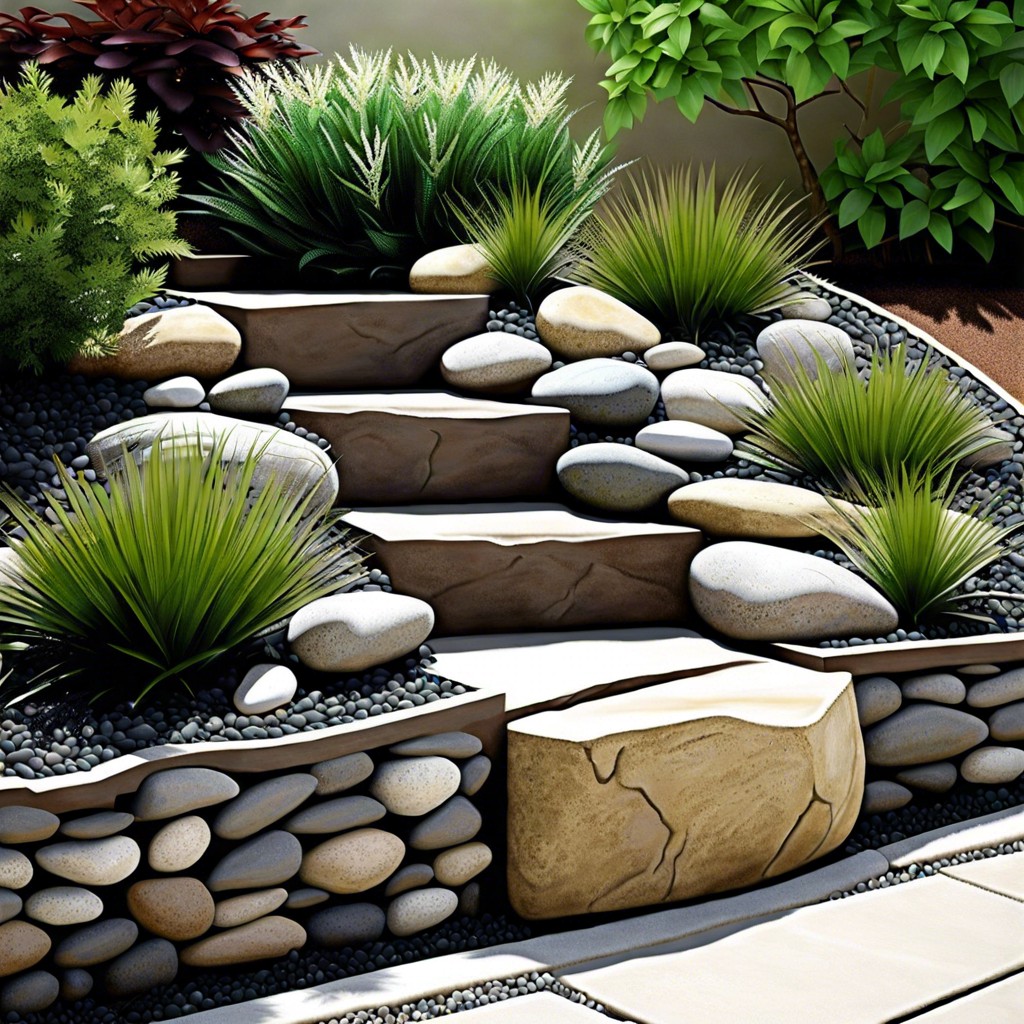Transform your outdoor space with the perfect selection of landscaping stones—this article will guide you in choosing the right types and styles to bring your garden vision to life.
Key takeaways:
- Landscaping rocks are available in a variety of types and styles.
- These rocks offer both aesthetic and functional benefits in your outdoor space.
- You can use landscaping rocks to create focal points, line pathways, and edge flower beds.
- You can find landscaping stones at local garden centers, online retailers, and stone yards.
- Calculating the amount of stone you need is straightforward with a few measurements.
Types of Landscaping Rocks

Dipping our toes into the vibrant ocean of landscaping rocks, we discover a treasure trove of options. Picture this: pebbles and gravel, perfect for crafting that walkway with a crunch underfoot that’s music to the ears. These small yet mighty stones create a crisp, clean look while allowing water to percolate, saying “so long” to puddles.
Now, imagine the elegance of river rocks, smooth and rounded from years of whispers with running water. These gems provide a sense of serenity and are a natural fit for water features – ever thought of defaulting to a Zen garden? They’re like nature’s stress balls, minus the squeezing.
For those with a taste for the dramatic, enter stage right: boulders. These big boys are the grand statements in the garden performance, anchors in the visual symphony telling a story of stability and timeless strength.
Flagstones, the puzzle pieces of natural stone, invite you to pave patios and paths with their flat, shapely forms. They’re the go-to for a game of backyard hopscotch or merely a stable and stylish sunbathing spot without those pesky chair legs sinking into the grass.
And lastly, the unsung heroes: decomposed granite and crushed stone. They’re the chameleons of the stone family, blending into driveways, paths, and even as a base for other stones, setting the stage for a backyard Broadway hit.
Each rock type brings its own character to the landscape stage. They’re not just a pretty face either; they stand tall against erosion, suppress weeds, and even provide a home for beneficial critters. Just goes to show, stones in the landscape are more than mere decorations—they’re the ruggedly handsome actors of outdoor design.
How To Use Landscaping Rocks
Imagine playing a game of Tetris, but with Mother Nature’s gifts. That’s right, incorporating landscaping rocks can be as fun as it is functional. Here’s how to get the ball rolling:
- Create a focal point in your garden with boulders: Just like a statement piece in fashion, a well-placed boulder draws the eye and anchors your outdoor design.
- Line pathways with pea gravel: It’s like sprinkling cookie crumbs to guide your guests along garden paths – only much prettier and less tempting to ants.
- Install a rock garden for drought-resistant flair: If you’re tired of thirsty plants, a rock garden is like a cactus’ dream home – low on water, high on style.
- Use river rocks for drainage: Think of this as the landscape’s plumbing system; river rocks help water flow where it should instead of pooling where it shouldn’t.
- Edge your flower beds with stone borders: Like putting a belt on a nice outfit, edging with stones cinches the look of your garden beds while keeping mulch in its place.
- Arrange rocks to create a natural retaining wall: Perfect for sloping gardens, a rock retaining wall is like a trusty shelf, preventing soil from slipping down hill.
No matter what you choose, incorporating stones in your landscaping is like giving your yard a touch of nature’s bling – functional, aesthetically pleasing, and ever-reliable.
Where To Buy Landscaping Stones
Embarking on a landscaping project can be as thrilling as a kid in a candy store, but knowing where to scoop up your dream stones is key to starting off on the right foot. Here are handy pointers to help guide you through the rock procurement process.
- Local Garden Centers: **
- Your neighborhood garden center is a treasure trove of knowledge and landscaping stones. Pay them a visit, and you’ll find stacks of rocks ideal for your needs. Plus, you can get professional advice and see the products firsthand before making a decision.
- Stone Yards and Quarries: **
- For a broader selection, consider visiting stone yards or quarries. They tend to offer a range of options in both natural and manufactured stones. If you’re looking for bulk quantities, this could be your jackpot.
- Online Retailers: **
- Need convenience? Online retailers are like genies of the rock world, offering doorstep delivery. Be sure to compare prices and read reviews to hit the mark with your online purchase.
- Landscaping Professionals: **
- Don’t overlook the pros. Landscapers often have the inside scoop on the best places to buy and sometimes have partnerships that could get you a good deal.
- DIY or Salvage Yards: **
- For the intrepid DIY enthusiast, salvage yards can yield unexpected, budget-friendly finds. You might discover the perfect stones that add an element of whimsy or charm to your garden.
Remember, the quest for the right stones is part of the landscaping adventure. So go forth, explore your options, and may your garden’s path be paved with the perfect picks!
How Much Stone Do I Need?
Calculating the right amount of stone for your landscaping project might seem like you’re trying to solve a puzzle, but it’s actually pretty straightforward. Think of it as piecing together the perfect outfit: you need to know your measurements to make sure everything fits just right.
First things first, measure your space. Grab that trusty tape measure and jot down the length and width of the area you want to rock out. Multiplying these two numbers gives you the square footage — this is your magic number.
Now, let’s talk depth. Like a good lasagna, layers are key. For good ground coverage that’s also effective at keeping weeds down, you’ll want a depth of about 2 inches. But if you’re covering a driveway, you’ll want to go 4 inches or more to handle the weight of vehicles.
Alright, here’s where a pinch of math spices things up. One cubic yard of stone covers about 100 square feet at 2 inches deep. So, divide your magic number by 100, and that’s roughly how many cubic yards you’ll need.
Remember, if you’re ever at a crossroads, local landscaping material suppliers are always up for a good chinwag. They can guide you through getting the perfect amount, so you don’t end up with a mountain of excess rock or a stingy sprinkle. Happy landscaping!
Serving New York Since 2016
Having our roots planted in the rich soil of New York’s bustling urban landscape for over half a decade, we’ve become a familiar face to locals seeking enhancement for their outdoor spaces. We have watched trends ebb and flow, and our experience allows us to adapt to New Yorkers’ evolving tastes in landscaping design.
Our journey since 2016 has seen us forge relationships with both suppliers and customers, creating a network that values quality and service. This homegrown approach means that when you talk to us about your landscaping ideas, you’re speaking with folks who understand the climatic challenges and aesthetic aspirations unique to New York.
An added bonus of our local expertise is that we’ve been able to keep an eye out for the New York environment. We’re proud to offer sustainable options that contribute to the health of our local ecosystem. We believe that beauty and responsibility can go hand in hand, even in a concrete jungle.
By aligning with artisans and quarries close to home, we’ve been able to reduce our carbon footprint without compromising on options. Whether you’re looking for the strong silent type like granite to weather the storms or the understated elegance of river rocks, rest assured, we’ve been putting down roots to serve you better. After all, locals know best, right?
